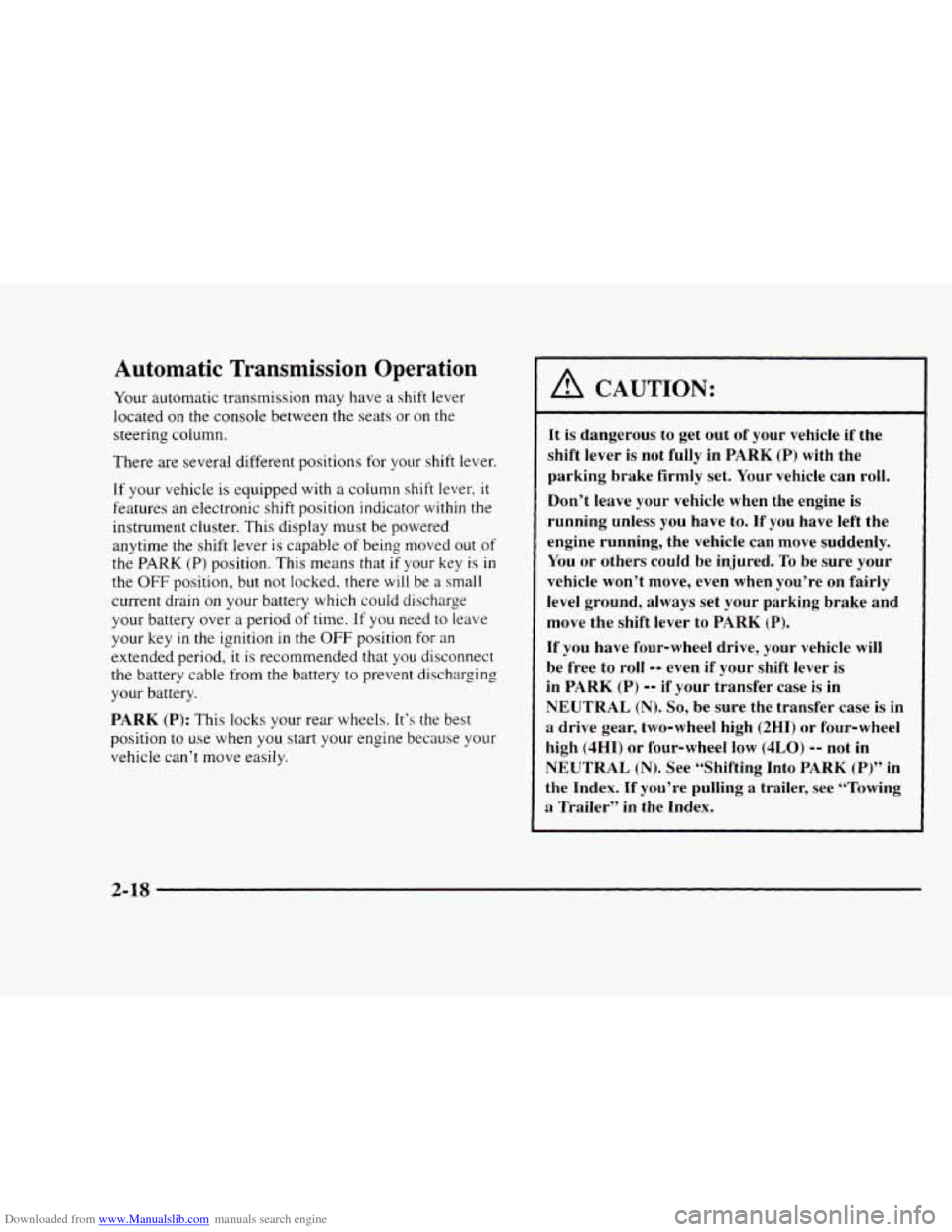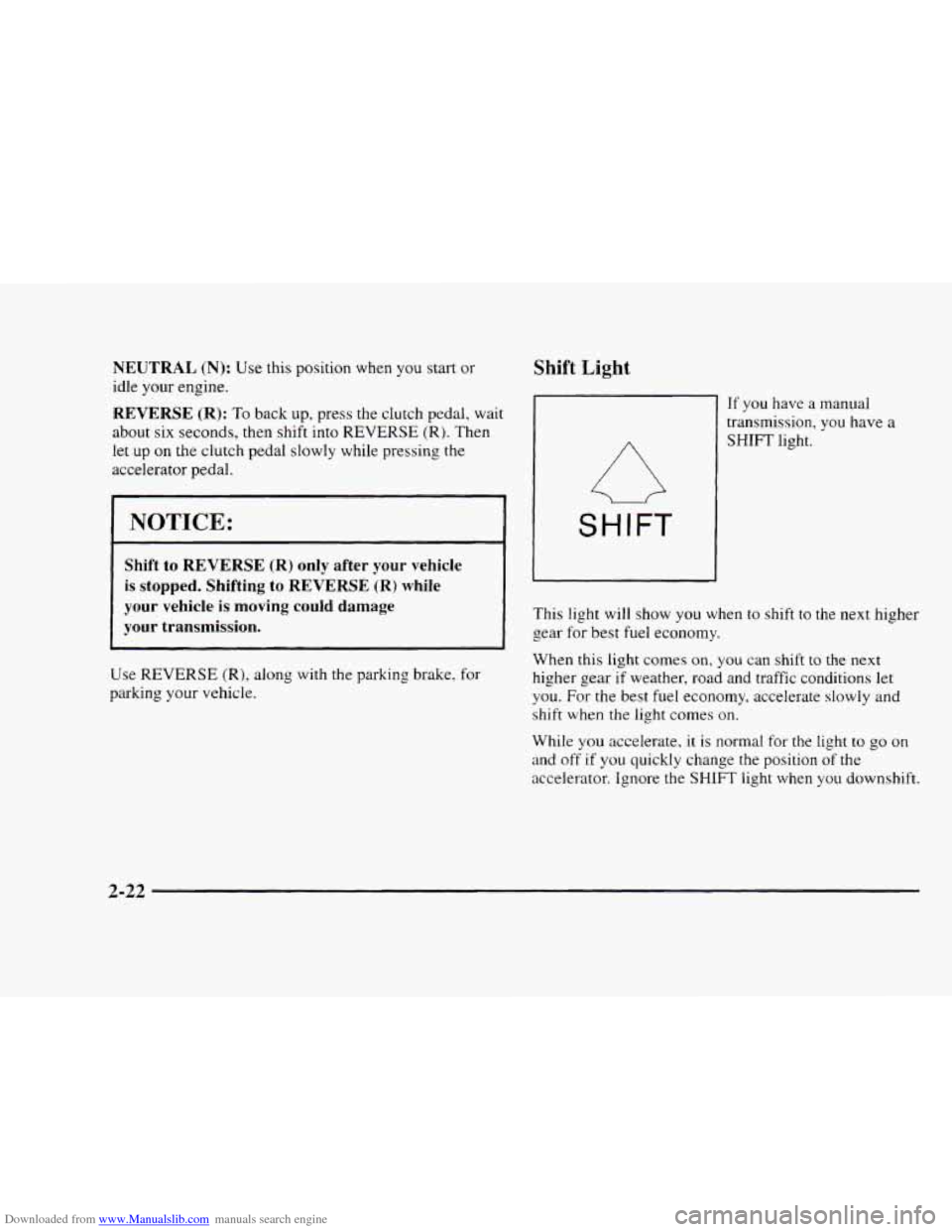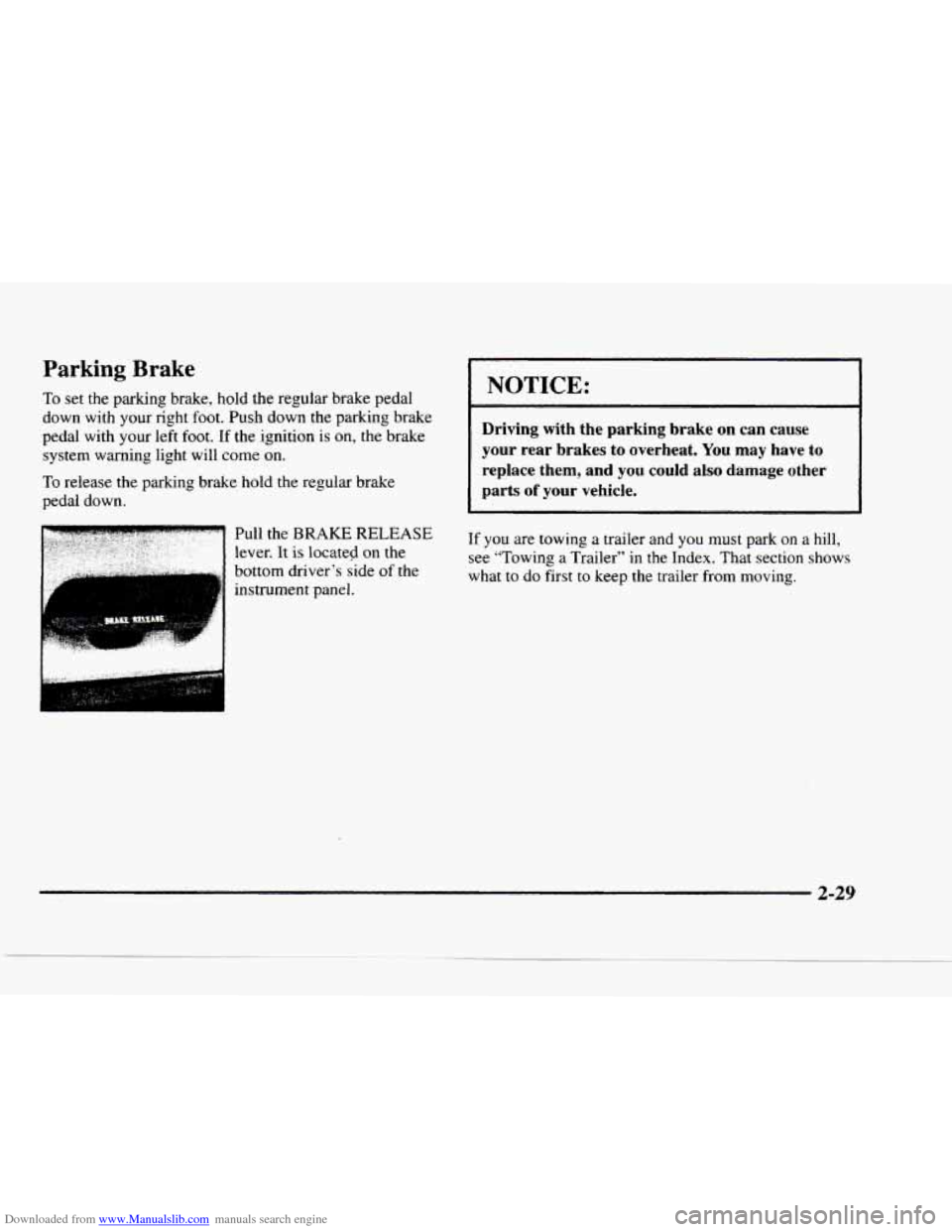1997 CHEVROLET BLAZER parking brake
[x] Cancel search: parking brakePage 58 of 402

Downloaded from www.Manualslib.com manuals search engine Section 2 Features and Controls
Here you can learn about the many standard and optional features on your vehicle, and information on starting,
shifting and braking.
Also explained are the instrument panel and the warning systems that tell you if everything is
working properly -- and what to do if you have a problem.
2-2
2-6
2-9
2- 12
2-13
2-
13
2- 15
2-
17
2-18
2-2 1
2-23
2-23
2-23
2-29
2-30
2-33 Keys
Keyless Entry
System
(If Equipped)
Endgatekiftgate
Theft
New Vehicle “Break-In”
Ignition Positions
Starting Your Engine
Engine Coolant Heater (Option)
Automatic Transmission Operation
Manual Transmission
Locking Rear Axle
All-Wheel Drive (If Equipped)
Four-wheel Drive (If Equipped)
Parking Brake
Shifting Into
PARK (P) (Automatic
Transmission Models Only)
Shifting Out
of PARK (P)
(Automatic Transmission) 2-33
2-34
2-34
2-35
2-36
2-38
2-45
2-49
2-63
2-63
2- 64
2-67
2-72 Parking
Your Vehicle (Manual Transmission
Models Only) Parking Over Things That Burn
Engine Exhaust
Running Your Engine While You’re Parked
(Automatic Transmission)
Windows
Turn SignaVMultifunction Lever Exterior Lamps
Mirrors
Accessory Power Outlets (If Equipped)
Sunroof
(If Equipped)
Universal Transmitter
(If Equipped)
Instrument Panel
Warning Lights, Gages and Indicators
Page 64 of 402

Downloaded from www.Manualslib.com manuals search engine Operation
When you press UNLOCK, the driver’s door and endgate will unlock automatically.
If you press
UNLOCK again within five seconds, all doors will
unlock. Press
LOCK to lock all the doors.
Battery Replacement
Under normal use, the battery in your remote keyless
entry transmitter should
last about two years.
Press the REAR button twice within
3 1/2 seconds to
unlock and unlatch
the rear glass. If your vehicle has
an automatic transmission, the transmission must be
in PARK (P) or NEUTRAL (N).
If your vehicle has
a manual transmission, you must engage the
parking brake.
Matching Transmitter(s) To Your Vehicle
Each remote keyless entry transmitter is coded to
prevent another transmitter from unlocking your vehicle.
If a transmitter is lost or stolen, a replacement can be
purchased through your dealer. Remember to bring any
remaining transmitters
with you when you go to your
dealer. When
the dealer matches the replacement
transmitter to your vehicle, any remaining transmitters
must also be matched. Once your dealer has coded the
new transmitter, the lost transmitter will not unlock your
vehicle. Each vehicle can have only two transmitters
matched
to it.
You can tell the battery is weak if the transmitter won’t
work at the normal range in any location.
If you have to
get close to your vehicle before the transmitter works,
it’s probably time to change the battery.
NOTICE:
When replacing the battery, use care not to touch
any of the circuitry. Static from your body
transferred to these surfaces may damage
the transmitter.
2-7
Page 68 of 402

Downloaded from www.Manualslib.com manuals search engine Remote Rear Glass Release
REAR HATCH I
This button on the driver's
side
of the steering column
allows
you to release the
rear glass from inside
the vehicle.
If your vehicle has an automatic transmission, your shift
lever must be
in PARK (P) or NEUTRAL (,N) for the
release to work.
If you have
a manual transmission, either with or
without the Keyless Entry option, you must apply your
parking brake before you can open
the endgate glass.
Liftgate Release
Insert the key in the lock button and turn
counterclockwise. All doors will unlock. You may also use
the power lock switches or the keyless entry system, if
your vehicle
is so equipped. Use the handle to open the
liftgate. Press the button
to open the glass when the liftgate
is closed. The glass won't release if the vehicle
is in gear.
Emergency Release for Opening
EndgateLiftgate
1. Peel back or slit the carpet locally to expose the
access hole
in the trim panel.
ii 2. Use a thin screwdriver
1
~ 2'''
to reach through the
access holes in both the
trim panel and the
hardware cover.
Pry the release lever
toward the passenger's
side until
the glass latch
pops open.
3. Reattach the carpet securely.
- 44
Page 75 of 402

Downloaded from www.Manualslib.com manuals search engine Automatic Transmission Operation
Your automatic transmission may have a shift lever
located
on the console between the seats or on the
steering column.
There are several different positions
for your shift lever.
If your vehicle is equipped with a coiunm shift lever, it
features an electronic shift position indicator within the
instrument cluster. This display must be powered
anytime the shift lever is capable of being moved out of
the
PARK (P) position. This means that if your key is in
the
OFF position, but not locked, there will be a small
current drain
on your battery which could discharge
your battery over
a period of time. If you need to leave
your key
in the ignition in the OFF position for an
extended period, it is recommended that you disconnect
the battery cable from the battery to prevent discharging
your battery.
PARK (P): This locks your rear wheels. It’s the best
position to use when you start your engine because your
vehicle can‘t move easily.
A CAUTION:
It is dangerous to get out of your vehicle if the
shift lever
is not fully in PARK (P) with the
parking brake firmly set. Your vehicle can roll.
Don’t leave your vehicle when the engine
is
running unless you have to. If you have left the
engine running, the vehicle can move suddenly.
You or others
could be injured. To be sure your
vehicie won’t move, even when you’re on fairly
level ground, always set your parking brake and
move the shift lever to
PARK (P).
If you have four-wheel drive, your vehicle will
be free to
roll -- even if your shift lever is
in PARK (P) -- if your transfer case is in
NEUTRAL (N). So, be sure the transfer case is in
a drive gear, two-wheel high (2HI) or four-wheel
high (4HI) or four-wheel low (4LO) -- not in
NEUTRAL (Nj. See “Shifting Into PARK (P)” in
the Index.
If you’re pulling a trailer, see “Towing
a Trailer” in the Index.
2-18
Page 79 of 402

Downloaded from www.Manualslib.com manuals search engine NEUTRAL (N): Use this position when you start or
idle your engine.
REVERSE (R): To back up, press the clutch pedal, wait
about six seconds, then shift into
REVERSE (R). Then
let up
on the clutch pedal slowly while pressing the
accelerator pedal.
NOTICE:
Shift to REVERSE (R) only after your vehicle
is stopped. Shifting to REVERSE (R) while
your vehicle is moving could damage
your transmission.
Use REVERSE (R), along with the parking brake, for
parking your vehicle.
Shift Light
SHIFT
If you have a manual
transmission, you have
a
SHIFT light.
This light will show you when
to shift to the next higher
gear for best fuel economy.
When this light comes
on, you can shift to the next
higher gear if weather, road and traffic conditions let
you. For the best fuel economy, accelerate slowly and
shift when the light comes
on.
While you accelerate. it is normal for the light to go on
and off if you quickly change the position of the
accelerator. Ignore the SHIFT light when you downshift.
2-22
Page 82 of 402

Downloaded from www.Manualslib.com manuals search engine The front axle portion of the diagram on the indicator
will light up when you shift
into four-wheel drive. A
slight delay between shifting and the pattern’s lighting is
normal. If the pattern does not light up, or if the front
axle lights do not go out after you shift out of
four-wheel drive, have your dealer check your system.
Turn the INT LIGHTS switch located to the right of
your headlamp switch
to dim your transfer case
indicator light when your headlamps or parking lamps
are on. This will also cause your instrument panel lights
to dim.
2HI: This setting is for driving in most street and
highway situations. Your front axle is
not engaged in
two-wheel drive.
4HI: This setting engages your front axle to help
drive
your vehicle. Use 4HI when you need extra
traction, such as on snowy
or icy roads, or in most
off-road situations.
N SET PARK BRAKE: Shift to this neutral setting
only when your vehicle needs to be towed.
4LO: This setting also engages your front axle to give
you extra traction and provides extra gear reduction.
You may never need 4LO. It sends the maximum power
to all four wheels. You might choose 4LO if you were
driving off-road in sand, mud or deep snow and
climbing or descending steep hills.
You can shift from 2HI to 4HI or from 4HI to 2HI while
the vehicle is moving. Do not press the transfer case
shift lever button when shifting from 2HI
to 4HI or
from 4HI to 2HI.
To shift your transfer case into N SET PARK BRAKE:
1. Stop the vehicle and shift your transmission into
NEUTRAL
(N).
2. Set the parking brake. Your vehicle can roll unless
the brakes are applied.
3. Pull the transfer case shift lever into N SET
PARK BRAISE.
2-25
Page 86 of 402

Downloaded from www.Manualslib.com manuals search engine Parking Brake
To set the parking brake, hold the regular brake pedal
down with your right foot. Push down the parking brake
pedal with your left
foot. If the ignition is on, the brake
system warning light will come
on.
To release the parking brake hold the regular brake
pedal down.
Pull the
BRAKE RELEASE
lever. It is located on the
bottom driver’s side
of the
instrument panel. ..
NOTICE:
r
Driving with the parking brake on can cause
your rear brakes to overheat.
You may have to
replace them, and you could also damage other
parts
of your vehicle.
If you are towing a trailer and you must park on a hill,
see “Towing a Trailer” in the Index. That section shows
what to do first to keep the trailer from moving.
2-29
Page 87 of 402

Downloaded from www.Manualslib.com manuals search engine Shifting Into PARK (P) (Automatic
Transmission
Models Only)
A CAUTION:
~~
It can be dangerous to get out of your vehicle .. ,. if I
the shift lever is not fully in PARK (P) with the
parking brake firmly set. Your vehicle can roll.
If you have left the engine running, the vehicle can
move suddenly. You
or others could be injured.
To be sure your vehicle won’t move, even when
you’re
on fairly level ground, use the steps that
follow.
If you have fourwheel drive with a manual
transfer case shift lever
and your transfer case is
in NEUTRAL (N), your vehicle will be free to roll,
even
if your shift lever is in PARK (P). So, be sure
the transfer case is in
a drive gear -- not in
NEUTRAL (N). If you’re pulling a trailer, see
“Towing a ’Iltailer” in the Index.
Column Shift Lever
1. Hold the brake pedal down with your right foot and
2. Move the shift lever into PARK (P) position ‘like this:
set the parking brake.
0 Pull the lever toward you.
2-30